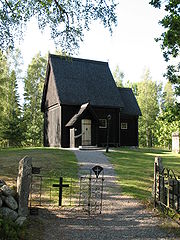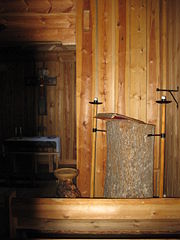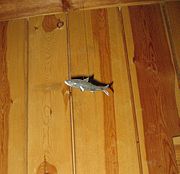
Skaga stave church
Encyclopedia




Stave church
A stave church is a medieval wooden church with a post and beam construction related to timber framing. The wall frames are filled with vertical planks. The load-bearing posts have lent their name to the building technique...
in Tiveden
Tiveden
Tiveden is a Swedish forest, throughout history notorious for its wilderness and dangers; historically a hiding place for outlaws.Within it, the Tiveden National Park has a designated area of 13.5 km², a comparatively small and arguably the most inaccessible part of the forest...
, Karlsborg Municipality
Karlsborg Municipality
Karlsborg Municipality is a municipality in Västra Götaland County in western Sweden. Its seat is located in the town of Karlsborg....
, Sweden
Sweden
Sweden , officially the Kingdom of Sweden , is a Nordic country on the Scandinavian Peninsula in Northern Europe. Sweden borders with Norway and Finland and is connected to Denmark by a bridge-tunnel across the Öresund....
. The original chapel was built in the 1130s during the Christianization of Scandinavia
Christianization of Scandinavia
The Christianization of Scandinavia took place between the 8th and the 12th century. The realms of Scandinavia proper, Denmark, Norway and Sweden, established their own Archdioceses, responsible directly to the Pope, in 1104, 1154 and 1164, respectively...
, but it was demolished in 1826 to combat persistent pagan practices in the area. The locals wanted their church back and worked for it to be rebuilt. In 1960, a reconstruction was inaugurated, but it burnt down in 2000. The following year, the church was rebuilt once again.
History and legends
The original church has been dated to the 1130s. During centuries, folklore has produced many legends on Skaga stave church. One of the legends relates that a Viking warrior named Ramunder the Evil owned a homestead at lake Unden nearby. His daughter Skaga was so weak when she was born that he decided to leave herInfant exposure
The motif of infant exposure is a recurring theme in mythology, especially among hero births.Some examples include:* Sargon, King of Agade - Exposed to the river.* Moses - Exposed in a vessel made of reeds on the river.* Karna - Exposed to the river....
in the forest to be devoured by wild beasts, which was an old Scandinavian custom when children were not desired. However, one of Ramunder's dogs discovered her and carried her back home. The mother thought this to be a sign from the Norse gods and let her live. Some time later, Ramunder departed on a Viking expedition and one of the spoils he brought back from the South was a monk. The monk and Skaga became good friends, and he baptized her in secret, and later when Skaga had inherited the homestead, she had the stave church built where people conducted their pagan sacrifices
Blót
The blót was Norse pagan sacrifice to the Norse gods and the spirits of the land. The sacrifice often took the form of a sacramental meal or feast. Related religious practices were performed by other Germanic peoples, such as the pagan Anglo-Saxons...
, in order to help the Christianization of the area. Eventually it became the church of its own parish.
In the 14th century, the Black Death
Black Death
The Black Death was one of the most devastating pandemics in human history, peaking in Europe between 1348 and 1350. Of several competing theories, the dominant explanation for the Black Death is the plague theory, which attributes the outbreak to the bacterium Yersinia pestis. Thought to have...
arrived and killed the entire population in the parish. The forest reclaimed the pastures, the fields and the settlements. Generations later, when people anew settled in the area, the stave church was the only remaining building, and it was once again the centre of a parish. There are many traditions on how the chapel was rediscovered. One legend relates that a hunter spotted what he believed to be a mossy rock in the forest. On closer inspection he discovered that it was a building, and he passed through the verdant gate. In the darkness, he was frightened by discovering a sleeping bear, which he managed to kill.
Until 1774, there were services in the church four times per year: Lady Day
Lady Day
In the western Liturgical year, Lady Day is the traditional name of the Feast of the Annunciation of the Blessed Virgin in some English speaking countries. It is the first of the four traditional English quarter days. The "Lady" was the Virgin Mary. The term derives from Middle English, when some...
, Ascension of Jesus, Midsummer
Midsummer
Midsummer may simply refer to the period of time centered upon the summer solstice, but more often refers to specific European celebrations that accompany the actual solstice, or that take place on a day between June 21 and June 24, and the preceding evening. The exact dates vary between different...
and Michaelmas
Michaelmas
Michaelmas, the feast of Saint Michael the Archangel is a day in the Western Christian calendar which occurs on 29 September...
. Later, the clergymen refused to have any dealings with the church because of "its derelict condition", but it was likely that the aversion related to the sacrifices at the location. In 1779, the church forbade any services at the stave church in order to let the church rot away through disuse and disrepair, hopefully together with the local supersitions that surrounded the church.
Pagan rites and its destruction
The stave church was demolished by church authorities in 1826. The destruction was the result of the controversies surrounding the use of a nearby well for pagan sacrifices, a custom which likely predated the Christianization of the area. After the stave church had been built the pagan sacrifices were superficially Christianized and people said that they sacrificed to the "holy one in SkagenSkagen
Skagen is a projection of land and a town, with a population of 8,515 , in Region Nordjylland on the northernmost tip of Vendsyssel-Thy, a part of the Jutland peninsula in northern Denmark...
" who officially was John the Baptist
John the Baptist
John the Baptist was an itinerant preacher and a major religious figure mentioned in the Canonical gospels. He is described in the Gospel of Luke as a relative of Jesus, who led a movement of baptism at the Jordan River...
, the patron of the stave church. Those who conducted the sacrifices were people who wanted help against an illness, but they could also want a better harvest or more luck when hunting and fishing. It is said that one man did not succeed in catching any bleaks in the nearby lake and so he had a silver fish crafted and which was hung above the pulpit.
The sacrifices were often given in recognition of having received help, and they were of various kinds: rings, clothes, hides, coins, etc. Throughout the years, the amassed wealth of offerings came to be very high, and people said "we should be able to raise the church on pillars of gold". The main church at nearby Undenäs benefited from the sacrifices and regularly reaped what people had left, but it kept the wealth for itself and allowed the old stave church to deteriorate. The clergymen of the Diocese of Skara
Diocese of Skara
The Diocese of Skara is a diocese of the Church of Sweden , with its seat at Skara in Västergötland...
appealed to the Parliament of Sweden
Parliament of Sweden
The Riksdag is the national legislative assembly of Sweden. The riksdag is a unicameral assembly with 349 members , who are elected on a proportional basis to serve fixed terms of four years...
for a crackdown on the sacrifices, and they wanted an end to the superstition that surrounded the "abomnable pagan shrine".
In spite of protests from the parishioners, the Diocese had the church demolished, but the destruction could not take place before the death of Pehr Tham, who actively protected the church and died in 1820.

